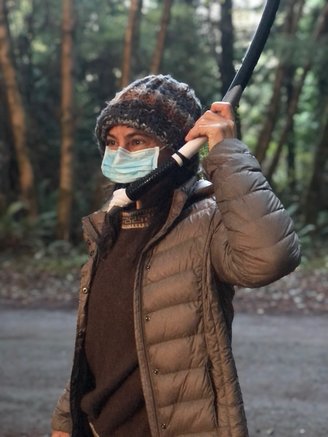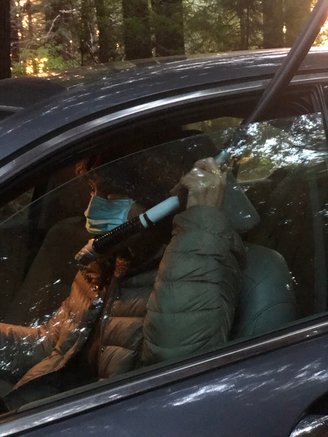
From
the beginning, there has been no shortage of resourceful efforts to
reclaim the simple luxuries of that sweet old COVID-free life we all
reminisce about.
Humboldt local Julie Sylvia has been innovative as a matter of necessity. She’s an applied behavioral analysis (ABA) technician, and her job sometimes requires being in the car with a client. Until recently, she wasn’t sure how to lower the risk of transmitting potentially virus-infected droplets to or from her passenger.
She weighed a few ideas. “I thought, ‘What can I do? Maybe I could just take some plastic and make a little divider in my car.’ And as I looked at my car, I thought — ‘that’s crazy hard,’” Sylvia told the Outpost recently. “Then I thought maybe I could put myself inside a huge trash bag and then air it out the window. And then I’m like, ‘that sounds really dangerous.’”
The Centers for Disease Control and Prevention released guidelines for this very predicament, recommending face coverings, backseating passengers, opening the windows and using the outside air setting for ventilation rather than the recirculated air option.
But Sylvia and her family weren’t on board with those precautions, plus her client isn’t comfortable with having the windows down.

Enter the “Car Snorkel,” a homemade breathing device fashioned from a snorkel, PVC (polyvinyl chloride) pipe and some duct tape. To make it, Sylvia stuffed a snorkel into a PVC pipe (by warming the plastics with the help of her stovetop, but she recommends that fellow Car Snorkel DIY-ers try a blow dryer instead) and reinforced the bind with duct tape. The device is a few feet long, and took only 10 minutes to assemble, Sylvia said.
In use, the invention involves inhaling through the snorkel mouthpiece while it’s threaded out her cracked driver’s side window. Meanwhile, Sylvia resituates her mask to cover her nose and exhales thataway.
“If you breathe in and out through your mouth, into the snorkel, which is such a long snorkel, you’re going to end up breathing back in your own air,” Sylvia explained. “Which will eventually make you dizzy, and that’s not safe for a driver.”
Using it takes a bit of concentration, Sylvia said.
Cons? She can’t talk while she’s using it, plus a little water gets in the car and in the snorkel pipe on rainy days. It also might be embarrassing for your passenger, Sylvia warned. She’s gotten a few funny looks here and there, but more often than that other drivers honk or flash a thumbs-up in COVID-safety (or maybe just comedic) solidarity.
But the pros? “It really works!” Sylvia said. “You can feel very confident that you’re not breathing any contaminated air.” She’s been using the Car Snorkel for two weeks now, and highly recommends it to others who can’t avoid commuting with folks from other households.
Of course, the only way to guarantee safety from COVID is to stay home. Out in the world, we all know it’s best to practice social distancing and avoid indoor interactions. Obviously, neither are really possible in a car, so if you are someone who must drive with others, you should probably follow those CDC recommendations. (It should go without saying that neither the CDC nor the World Health Organization nor anyone else in authority has yet endorsed the Car Snorkel as an effective coronavirus containment device.)
Have you dreamt up any nifty adaptations to COVID obstacles like this? If so, we want to know! Write jacquelyn@lostcoastoutpost.com.
CLICK TO MANAGE